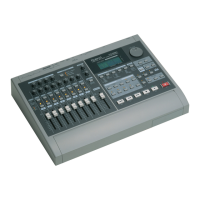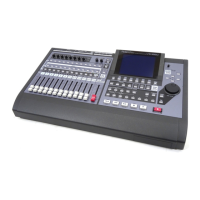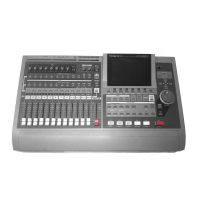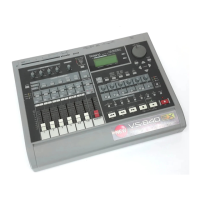14—Working with Track Channels
196 www.RolandUS.com Roland VS-2400CD Owner’s Manual
Sending a Track Channel’s Signal to a Direct Path
While you can send a track channel’s signal directly to an output using the track direct
outs (Page 274), doing so requires the disabling of all bus connections to your output
jacks. If you need to send Aux bus signals to outputs—perhaps for headphone mixes—
at the same time as you send your track channel signals there, send each track to an
output using a Direct path. To learn more about Direct paths, see Chapter 15.
Routing a Track to a Direct Path
1. Press the desired Tr 1-12 or Tr 13-24 button.
2. Press the desired track channel’s CH EDIT button.
3. Turn on the desired Direct path’s on/off switch (Page 151).
Mixing
The most important place to send a track channel’s signal is, of course, to the MASTER
mix bus when you create your final mix. While a complete discussion of how to mix is
far beyond the scope of the
VS-2400CD Owner’s Manual
, here’s a very brief overview of
the process to get you started, since track channel signals—the sound of your recorded
tracks—are the main ingredient of most VS-2400CD mixes.
Any discussion of mixing has to mention a mix’s other elements: effects and any live
input signals you’re using. Discussions of these topics can be found in other chapters.
The Mechanics of Mixing
A final mix is nothing more—or less—than the combining of all of the project’s audio
into a single stereo (or Surround) audio signal. That includes your recorded tracks,
effects you add to those recordings and any live input signals (such as MIDI
instruments) required to complete the project’s sound.
To create the final mix, send all project elements to the stereo MASTER bus.
• Recorded tracks—are sent to the MASTER mix from their track channels. If you’ve
inserted effects on any track channels, they go along for the ride as well.
• Loop effects—are sent to the MASTER mix from the FX return channels.
• Live input signals—are sent to the main mix from the input channels.
Make sure that the CH EDIT MIX parameter (Page 149) for any desired track, FX or
input channel is turned on if you want its signal to be sent to the MASTER bus.
Since you listen to the MASTER bus during most VS-2400CD operations, you’re really
already mixing as you balance the levels of your track channels just to make things
sound good as you work. The final mix may only mean a refinement of what you’ve
been listening to all along.
To learn about routing a Direct path to a VS-2400CD output, see Chapter 15.
If you’ve connected your VS-2400CD to a pair of Roland DS-90A or DS-50A Digital
Reference Monitors, you can try out your mix on a variety of different virtual speakers
to make sure your project sounds great wherever it’s played—see “Speaker Modeling”
on Page 219.
VS2400OMUS.book 196 ページ 2006年2月28日 火曜日 午前11時12分

